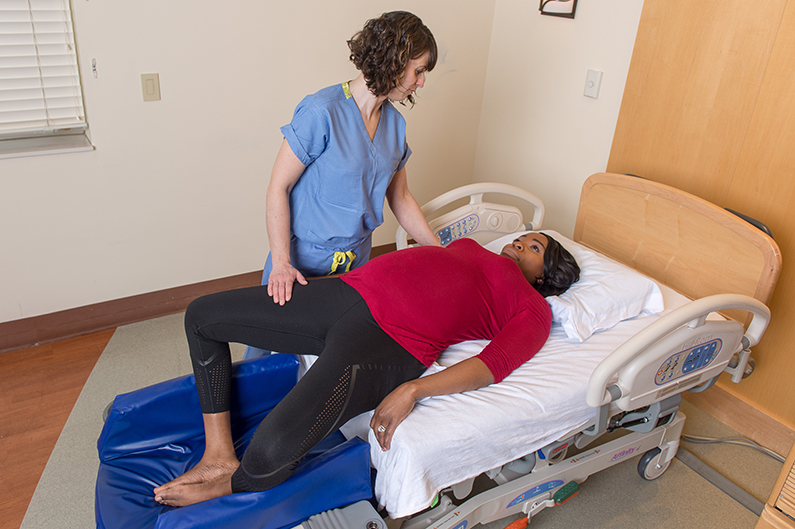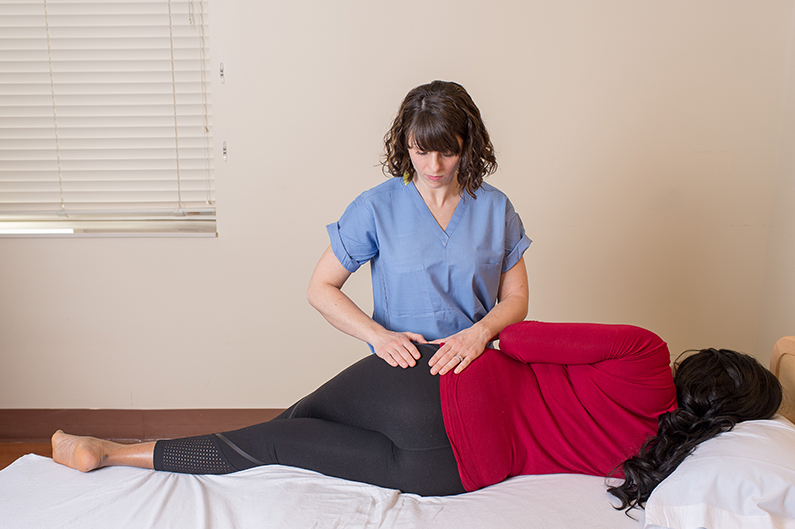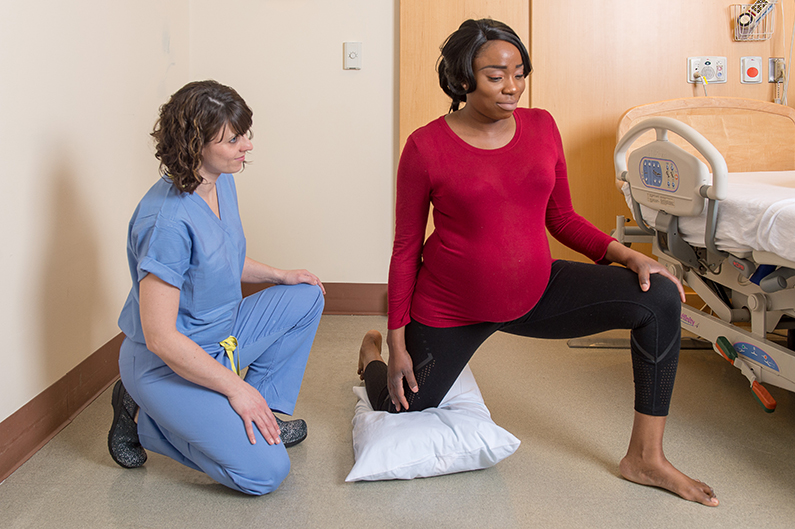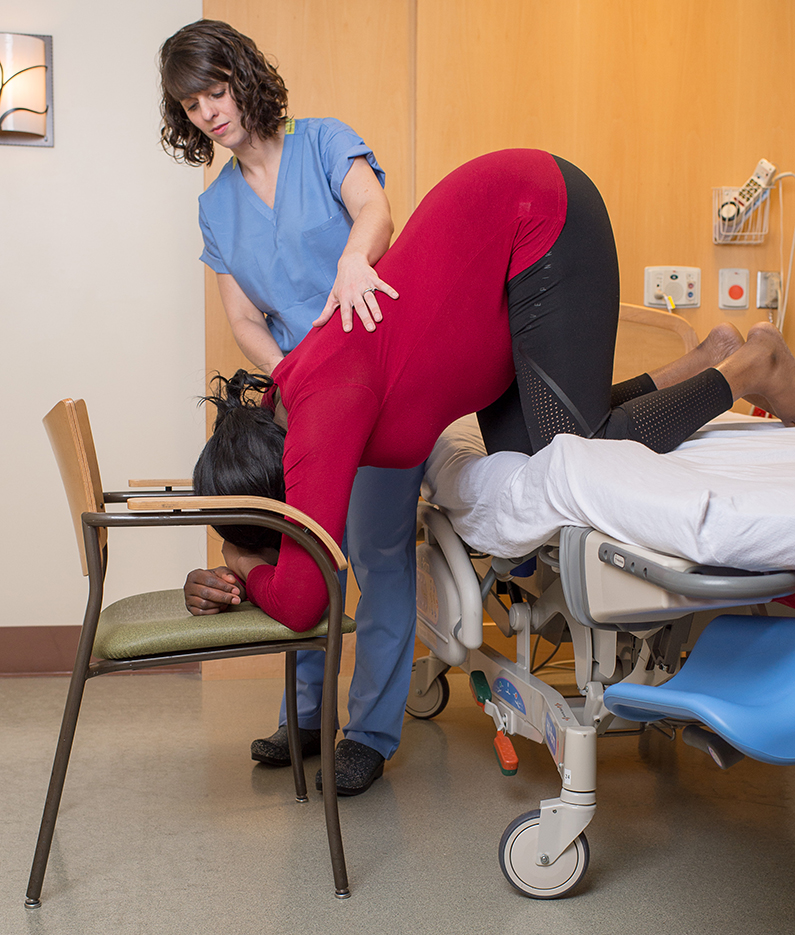Today, we’ll be looking at a birth story that ended in a cesarean, what led to that outcome, and discuss solutions for a labor dystocia lower in the pelvis.
Birth Scenario
A short history of the Birth Giver:
- First birth
- History of tailbone injury
- Fetal position ROT
- SROM (Spontaneous Rupture of Membranes)
- Nipple stimulation with a breast pump at the hospital
Baby entering pelvis from oblique. Baby’s bottom was on the mother’s right and the head was on the left, not centered.
Labor pattern
- 4 cm for a long time, -2 or -3
- Contractions spaced 6-8 minutes
- Contractions coupling
Epidural and Pitocin were in effect for over seven hours.
1 pm our Spinning Babies® nurse heroine comes in…
Rebozo Manteada on buttocks, Inverted Open Knee-Chest for 3 contractions, SLR. Changed birth position to sitting on edge of main portion of bed and feet lowered down. Holding the squat bar and doing hip circles helped baby’s head center over the pelvis.
 Froggy Walcher’s
Froggy Walcher’s
The coupling stopped until she laid down in which they began again. Froggie Walcher’s for 3 contractions. Small decel “Deep Variable” to 60 but went back up in 20-30 seconds.
Baby moved! Congratulations! Baby is Engaged!
5 pm
Next check in dilation: still 4 cm , -1 or 0 Station, well engaged but caput present at 4 cm. The next techniques were Inverted Knee Chest with elbows on lowered foot of bed, knees on main bed frame to try.
Our nurse cupped the sacrum with her and began a gentle and steady rocking side-to-side. Applied lateral pressure on one sacrotuberous ligament. Didn’t get to do the other side because of events in the room. Epidural is re-dosed.
 Sidelying Release
Sidelying Release
Sidelying Release repeated.
Our nurse left her shift. Usual care continued without the advantage of asking, “Where’s Baby?” and the solutions that evolve from that question.
8 pm
Next check in dilation was three hours later, 7 cm. A cervical lip remains for the next four hours. Baby was found to be ROT.
No descent, lip didn’t resolve. Cesarean was done to finish the birth.
Let’s see if we can explore what we know and what we might learn so we can match an effective technique.
What we know:
The hip circles and Walcher’s engaged baby quickly. Hip circles can loosen the muscles at the top of the back of the pelvis to ease rotation. Walcher’s opens the brim 1 cm.
What questions might yet have been answered?
What techniques might have been done at the time of the cervical lip?
Where’s baby?
Is baby in deep transverse arrest at 0 Station? Is baby asynclitic in the midpelvis?
 Kneeling Side Lunge
Kneeling Side Lunge
Try SLR followed by resting with a peanut ball with knees together feet apart or a bed lunge. If no epidural, Kneeling Side Lunge. Same protocol for -1 Station.
If baby is actually -2, FLI and Shake The Apples with the Rebozo over buttocks. Repeat even if done earlier in the labor.
For a Cervical Lip
Adjust the inversion to let the uterus actually hang fully. This is tricky on an epidural, get help. If it is a heavy epidural this may not be possible. Then jiggle only.
 Forward-Leaning Inversion
Forward-Leaning Inversion
FLI with jiggling of the hips and buttocks with the Rebozo or hands of the helpers. A full Forward-Leaning Inversion is more effective than Open-Knee Chest.
For Sacral Movement
Sidelying Release is number one. Standing Sacral is number one. Full sacrotuberous release is number one… wait, how can there be three number ones? They are all important at this point. Do what you can (no standing with an epidural).
Massage and jiggling around all edges of the pelvis; posterior crest, edges of sacrum, tuberosities, greater trochanter of femur. Massage is not enough.
Rock the sitz bones and hip bone in a gentle but effective “figure 8” about 9-12 times. Alternate directions but start with hip bone going forward for 3 circles and focus on hip bone going back. Don’t overdo it or you might damage the joints.
(Credits to Jenny Blyth and Fiona Hallinan of Birthwork in Australia)
With the tailbone history of injury
The pelvic floor is often pulled off balance and needs help to return to a more open, softer, more supple responsiveness every 2-4 hours in a case like this…
What was the real cause to finish the birth with surgery?
I still need a bit more information. Meanwhile, you’ve gotten some things to think about for the next time you find yourself in a labor dystocia lower in the pelvis.
Enjoy this post? You also might like:
- Labor Patterns
- Engaging Baby in Labor
- Preventing the Epidural Labor Stall
- What to Do When….(In Labor)
Upcoming Workshops
[tribe_events_list limit=”4″]
